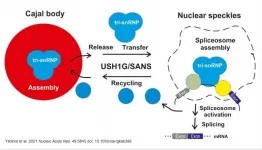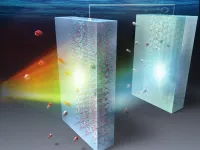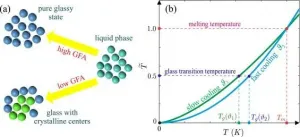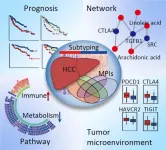INFORMATION:
* Source: Woods, HA; Pincebourde, S; Dillon, ME; & Terblanche, JS 2021. Extended phenotypes: buffers or amplifiers of climate change? Trends in Ecology and Evolution: doi.org/10.1016/j.tree.2021.05.010 1
*Art Woods (University of Montana), Sylvain Pincebourde (University of Tours), Michael Dillon (University of Wyoming) and John Terblanche (Stellenbosch University).
Humans can learn from animals and insects about impact of climate change
Crucial that we continuously improve our ability to predict and mitigate the effects of climate change
2021-07-12
(Press-News.org) If we pay closer attention to how birds, rabbits and termites transform their local living spaces in response to varying climate conditions, we could become much better at predicting what impact climate change will have on them in future.
This is according to a group of researchers* from the Universities of Montana and Wyoming in the United States, the University of Tours in France and Stellenbosch University (SU) in South Africa. They examined how animals' ability to respond to climate change likely depends on how well they modify their habitats, such as the way they build nests and burrows.
The findings of their study were published recently in the high-impact journal Trends in Ecology and Evolution.
"It's crucial that we continuously improve our ability to predict and mitigate the effects of climate change. One of the ways we can do this is by gaining a better understanding of how animals influence their own small-scale experience of climate at the level of individual members in a population," says one of the researchers, Prof John Terblanche from SU's Department of Conservation Ecology and Entomology.
Terblanche and his co-authors mention that in order to enhance the predictive power of typical contemporary climate change models, it will be important for biologists to understand how animals transform their living space locally in response to climate variability.
"Improving such models will be key to forecasting the effects of climate change on species, and to predict future effects, including how species ranges may shift and what the relative risks of extinction are for different animal species with high levels of precision."
They add that knowing which species will proliferate with climate change is central to understanding pest outbreaks on crops, or disease vectors changing risks for humans.
"Climate change will impact the spread of disease vectors, the health of marine and terrestrial biomes around the world and will influence whether agriculture and fishing will be able to continue supporting human populations, as they have in the past."
In their study, the researchers point out how some animals have found unique ways to protect themselves against extreme climate conditions.
"Many animals dig burrows, construct nests for themselves or their offspring, build homes for entire colonies (ants and termites), induce plants to produce galls, build leaf mines, or simply modify the structure or texture of their local environments.
"For example, birds build nests to keep eggs and chicks warm during cool weather, but also make adjustments in nest insulation to keep the little ones cool in very hot conditions. Mammals, such as rabbits or mice, sleep or hibernate in underground burrows that provide stable, moderate temperatures and avoid above-ground conditions that often are far more extreme outside the burrow.
"We've also seen how termites and ants build mounds that capture wind and solar energy to drive airflow through the colony, which stabilizes temperature, relative humidity, and oxygen level experienced by the colony."
The researchers say these modifications, known as extended phenotypes, filter climate into local sets of conditions immediately around the organism - 'the microclimate', which is key for a better understanding of the impact of climate change.
"Two features of microclimates are important. First, microclimates typically differ strongly from nearby climates, which means that the climate in an area may provide little information about what animals experience in their microhabitats. Second, because extended phenotypes are built structures, they often are modified in response to local climate variation, and potentially in response to climate change."
The researchers call for a renewed effort to understand how extended phenotypes mediate how organisms experience climate change. "We need a much better understanding of how much animals can adjust these structures in response to varying climate conditions," says Terblanche.
"Another key challenge is to understand how much flexibility there is in extended phenotypes, and how rapidly they can evolve. At this point, we pretty much have no idea whether these processes can keep up with climate change," adds lead author Art Woods from the University of Montana.
ELSE PRESS RELEASES FROM THIS DATE:
Remarkable new insights into the pathology of Usher syndrome
2021-07-12
Human Usher syndrome (USH) is the most common form of hereditary deaf-blindness. Sufferers can be deaf from birth, suffer from balance disorders, and eventually lose their eyesight as the disease progresses. For some 25 years now, the research group led by Professor Uwe Wolfrum of the Institute of Molecular Physiology at Johannes Gutenberg University Mainz (JGU) has been conducting research into Usher syndrome. Working in cooperation with the group headed up by Professor Reinhard Lührmann at the Max Planck Institute for Biophysical Chemistry in Göttingen, his team has now identified a novel pathomechanism leading to Usher syndrome. They have discovered that the Usher syndrome type 1G protein SANS plays a crucial role in regulating ...
Giving a "tandem" boost to solar-powered water splitting
2021-07-12
Turning away from fossil fuels is necessary if we are to avert an environmental crisis due to global warming. Both industry and academia have been focusing heavily on hydrogen as a feasible clean alternative. Hydrogen is practically inexhaustible and when used to generate energy, only produces water vapor. However, to realize a truly eco-friendly hydrogen society, we need to be able to mass-produce hydrogen cleanly in the first place.
One way to do that is by splitting water via "artificial photosynthesis," a process in which materials called "photocatalysts" leverage solar energy to produce oxygen and hydrogen from water. However, the available photocatalysts are not yet where they need to be to make solar-powered water splitting economically feasible and scalable. ...
Theoretical model able to reliably predict low-temperature properties of compounds
2021-07-12
Co-authors Bulat Galimzyanov and Anatolii Mokshin (Department of Computational Physics) have developed a unique model that allows for a universal interpretation of experimental data on viscosity for systems of different types, while also proposing an alternative method for classifying materials based on a unified temperature scale.
The publication was funded by Russian Science Foundation's grant 'Theoretical, simulation and experimental studies of physical and mechanical features of amorphous systems with inhomogeneous local viscoelastic properties', guided by Professor Mokshin.
Using the developed viscosity model, scientists processed experimental data obtained for thirty different ...
Study sheds light on precise personalized hepatocellular carcinoma medicine
2021-07-12
A research group led by Prof. PIAO Hailong from the Dalian Institute of Chemical Physics (DICP) of the Chinese Academy of Sciences (CAS) identified hepatocellular carcinoma (HCC) subtypes with distinctive metabolic phenotypes through bioinformatics and machine learning methods, and elucidated the potential mechanisms based on a metabolite-protein interaction network and multi-omics data.
The study, published in Advanced Science on July 11, provides insights guiding precise personalized HCC medicine.
Metabolic reprogramming, which can promote rapid cell proliferation by regulating energy and nutrient metabolism, is considered to be one hallmark of cancer. It can impact other biological processes through complex metabolite-protein ...
Want to avoid running overuse injuries? Don't lean forward so much, says CU Denver study
2021-07-12
The ubiquitous overuse injuries that nag runners may stem from an unlikely culprit: how far you lean forward.
Trunk flexion, the angle at which a runner bends forward from the hip, can range wildly--runners have self-reported angles of approximately -2 degrees to upward of 25. A new study from the END ...
Heart risk 'calculators' overlook increased risk for people of South Asian ancestry
2021-07-12
DALLAS, July 12, 2021 -- People of South Asian ancestry have more than double the risk of developing heart disease compared to people of European ancestry, yet clinical risk assessment calculators used to guide decisions about preventing or treating heart disease may fail to account for the increased risk, according to new research published today in the American Heart Association's flagship journal Circulation.
About a quarter of the world's population (1.8 billion people) are of South Asian descent, and prior research has shown South Asians experience higher rates of heart disease compared to people of most other ethnicities.
To better understand the variables surrounding the heart disease risk for people of South Asian ancestry, researchers evaluated ...
Innovative gene therapy 'reprograms' cells to reverse neurological deficiencies
2021-07-12
A novel method of gene therapy is helping children born with a rare genetic disorder called AADC deficiency that causes severe physical and developmental disabilities. The study, led by researchers at The Ohio State University Wexner Medical Center and The Ohio State University College of Medicine, offers new hope to those living with incurable genetic and neurodegenerative diseases.
Research findings are published online in the journal Nature Communications.
This study describes the findings from the targeted delivery of gene therapy to midbrain to treat a rare ...
USC researchers discover better way to identify DNA variants
2021-07-12
USC researchers have achieved a better way to identify elusive DNA variants responsible for genetic changes affecting cell functions and diseases.
Using computational biology tools, scientists at the university's Dornsife College of Letters, Arts and Sciences studied "variable-number tandem repeats" (VNTR) in DNA. VNTRs are stretches of DNA made of a short pattern of nucleotides repeated over and over, like a plaid pattern shirt. Though they comprise but 3% of the human genome, the repetitive DNA governs how some genes are encoded and levels of proteins are produced in a cell, and account for most of the structural variation.
Current methods do not accurately detect the variations in genes in some repetitive ...
Scientists blueprint bacterial enzyme believed to "stealthily" suppress immune response
2021-07-12
Scientists have produced the first fine-detail molecular blueprints of a bacterial enzyme known as Lit, which is suspected to play a "stealthy" role in the progression of infection by reducing the immune response.
Blueprints such as these allow drug designers to uncover potential weaknesses in bacterial arsenals as they seek to develop new therapeutics that may help us win the war against antibiotic resistance.
The study, led by scientists from the School of Biochemistry and Immunology and the Trinity Biomedical Sciences Institute (TBSI) at Trinity College Dublin, has just been published by leading international journal Nature Communications.
Lipoproteins and their role in ...
A Trojan horse could help get drugs past our brain's tough border patrol
2021-07-12
Sclerosis, Parkinson's Disease, Alzheimer's and epilepsy are but a few of the central nervous system disorders. They are also very difficult to treat, since the brain is protected by the blood-brain barrier.
The blood-brain barrier works as a border wall between the blood and the brain, allowing just certain molecules to enter the brain. And whereas water and oxygen can get through, as can other substances such as alcohol and coffee. But it does block more than 99 percent of potentially neuroprotective compounds from reaching their targets in the brain.
Now, ...
LAST 30 PRESS RELEASES:
Air pollution exposure and birth weight
Obstructive sleep apnea risk and mental health conditions among older adults
How talking slows eye movements behind the wheel
The Ceramic Society of Japan’s Oxoate Ceramics Research Association launches new international book project
Heart-brain connection: international study reveals the role of the vagus nerve in keeping the heart young
Researchers identify Rb1 as a predictive biomarker for a new therapeutic strategy in some breast cancers
Survey reveals ethical gaps slowing AI adoption in pediatric surgery
Stimulant ADHD medications work differently than thought
AI overestimates how smart people are, according to HSE economists
HSE researchers create genome-wide map of quadruplexes
Scientists boost cell "powerhouses" to burn more calories
Automatic label checking: The missing step in making reliable medical AI
Low daily alcohol intake linked to 50% heightened mouth cancer risk in India
American Meteorological Society announces Rick Spinrad as 2026 President-Elect
Biomass-based carbon capture spotlighted in newly released global climate webinar recording
Illuminating invisible nano pollutants: advanced bioimaging tracks the full journey of emerging nanoscale contaminants in living systems
How does age affect recovery from spinal cord injury?
Novel AI tool offers prognosis for patients with head and neck cancer
Fathers’ microplastic exposure tied to their children’s metabolic problems
Research validates laboratory model for studying high-grade serous ovarian cancer
SIR 2026 delivers transformative breakthroughs in minimally invasive medicine to improve patient care
Stem Cell Reports most downloaded papers of 2025 highlight the breadth and impact of stem cell research
Oxford-led study estimates NHS spends around 3% of its primary and secondary care budget on the health impacts of heat and cold in England
A researcher’s long quest leads to a smart composite breakthrough
Urban wild bees act as “microbial sensors” of city health.
New study finds where you live affects recovery after a hip fracture
Forecasting the impact of fully automated vehicle adoption on US road traffic injuries
Alcohol-related hospitalizations from 2016 to 2022
Semaglutide and hospitalizations in patients with obesity and established cardiovascular disease
Researchers ‘listen in’ to embryo-mother interactions during implantation using a culture system replicating the womb lining
[Press-News.org] Humans can learn from animals and insects about impact of climate changeCrucial that we continuously improve our ability to predict and mitigate the effects of climate change



